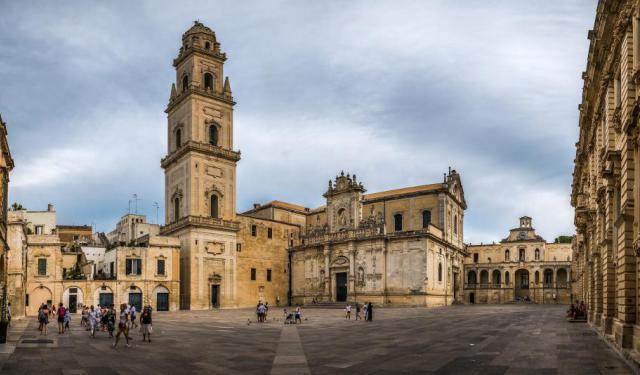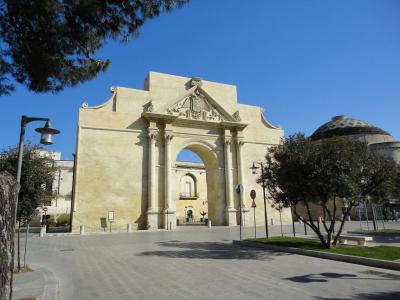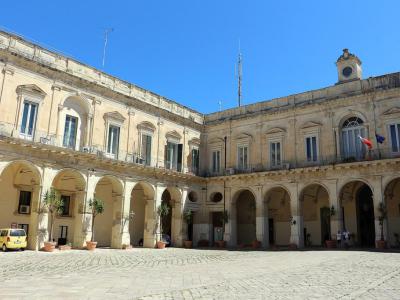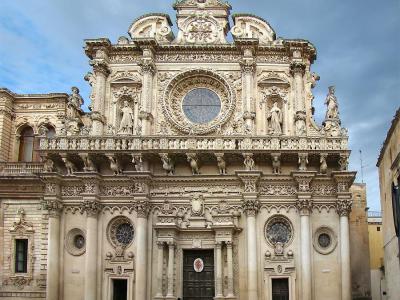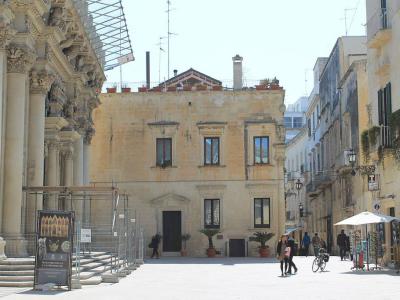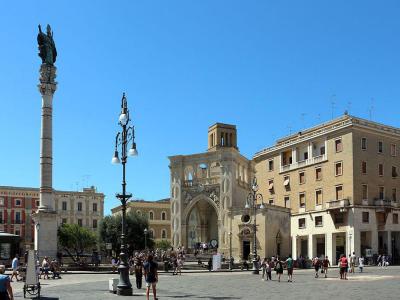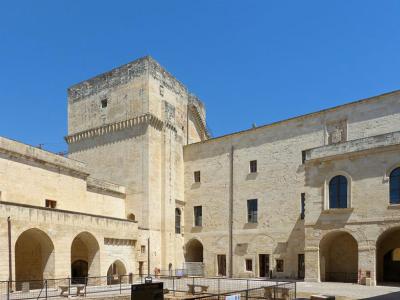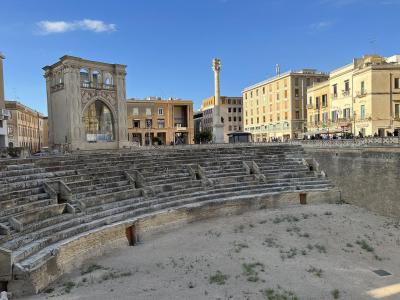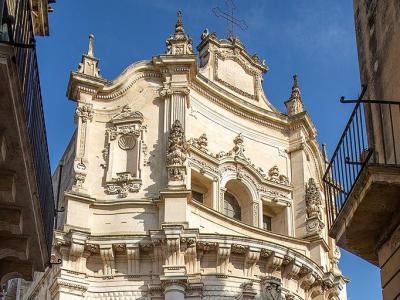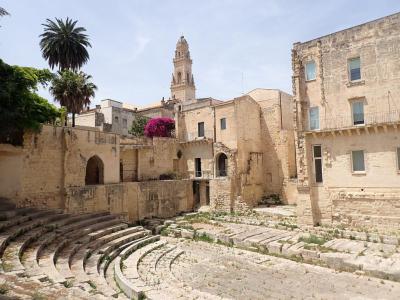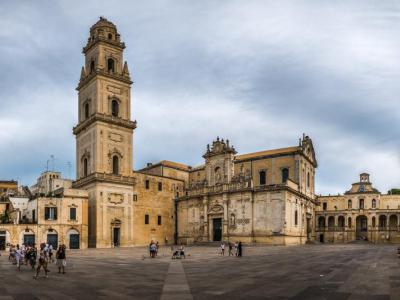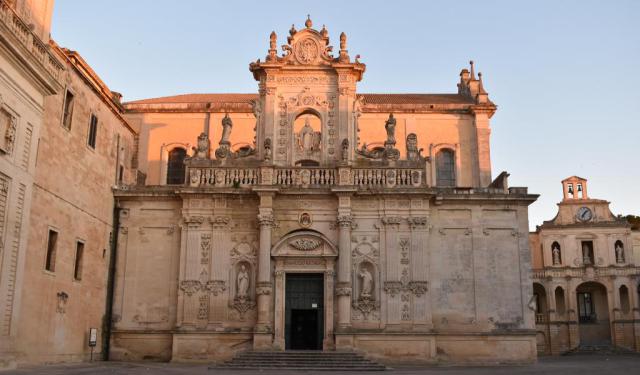Audio Guide: Lecce Introduction Walking Tour (Self Guided), Lecce
German historian Ferdinand Gregorovius called Lecce “the Florence of the Baroque era.” The city traces its beginnings around the time of the Trojan Wars, which took place around the 11th century BC. However, it first steps firmly into the record in the 3rd century BC as Lupiae under Roman control. The name is thought to come from lupus, the Latin word for wolf, recalling the animals that once roamed these lands. When Roman Emperor Hadrian came along, he decided the whole settlement needed moving-two miles northeast, to be precise-leaving behind an amphitheater and theatre that still peek out from under modern streets.
After the fall of Roman Empire, Lecce became a desired toy of new powers. The Byzantines, Lombards, and later Normans all left their mark, turning the town into a fortified stronghold, making Lecce a premier fief. By the late Middle Ages, Lecce had emerged as one of the most prosperous towns in the south of Italy, closely tied to the Kingdom of Naples, starting in 1282.
Skipping forward, the defining chapter came under Holy Roman Emperor Charles V in the 1500s, when city walls were strengthened to resist Ottoman raids. That era ushered in Lecce’s golden age: the 16th and 17th centuries under Spanish rule. Out of soft local limestone, craftsmen carved exuberant façades and columns, giving birth to the Baroque style that would earn the city its nickname, the “Florence of the South.” The Basilica of the Holy Cross is its crowning achievement, every inch of its exterior alive with mythical creatures, swirls, and symbols, while the Cathedral of Lecce, reworked in the same period, anchors Cathedral Square as the spiritual and civic heart of the city.
In the centuries that followed, Lecce lived under French Bourbon rule until the 19th century, when the unification of Italy folded it into the new nation. Through all the wars and changes of power, the golden stone façades endured, turning the city into a living museum of southern Italian history. If crowded, tourist-ridden cities are not your cup of tea, Lecce proves noteworthy as a “New Florence”, or at least, a must-see alternative.
After the fall of Roman Empire, Lecce became a desired toy of new powers. The Byzantines, Lombards, and later Normans all left their mark, turning the town into a fortified stronghold, making Lecce a premier fief. By the late Middle Ages, Lecce had emerged as one of the most prosperous towns in the south of Italy, closely tied to the Kingdom of Naples, starting in 1282.
Skipping forward, the defining chapter came under Holy Roman Emperor Charles V in the 1500s, when city walls were strengthened to resist Ottoman raids. That era ushered in Lecce’s golden age: the 16th and 17th centuries under Spanish rule. Out of soft local limestone, craftsmen carved exuberant façades and columns, giving birth to the Baroque style that would earn the city its nickname, the “Florence of the South.” The Basilica of the Holy Cross is its crowning achievement, every inch of its exterior alive with mythical creatures, swirls, and symbols, while the Cathedral of Lecce, reworked in the same period, anchors Cathedral Square as the spiritual and civic heart of the city.
In the centuries that followed, Lecce lived under French Bourbon rule until the 19th century, when the unification of Italy folded it into the new nation. Through all the wars and changes of power, the golden stone façades endured, turning the city into a living museum of southern Italian history. If crowded, tourist-ridden cities are not your cup of tea, Lecce proves noteworthy as a “New Florence”, or at least, a must-see alternative.
How it works: Download the app "GPSmyCity: Walks in 1K+ Cities" from Apple App Store or Google Play Store to your mobile phone or tablet. The app turns your mobile device into a personal tour guide and its built-in GPS navigation functions guide you from one tour stop to next. The app works offline, so no data plan is needed when traveling abroad.
Lecce Introduction Walking Tour Map
Guide Name: Lecce Introduction Walking Tour
Guide Location: Italy » Lecce (See other walking tours in Lecce)
Guide Type: Self-guided Walking Tour (Sightseeing)
# of Attractions: 10
Tour Duration: 2 Hour(s)
Travel Distance: 2.1 Km or 1.3 Miles
Author: DanaOffice
Sight(s) Featured in This Guide:
Guide Location: Italy » Lecce (See other walking tours in Lecce)
Guide Type: Self-guided Walking Tour (Sightseeing)
# of Attractions: 10
Tour Duration: 2 Hour(s)
Travel Distance: 2.1 Km or 1.3 Miles
Author: DanaOffice
Sight(s) Featured in This Guide:
- Porta Napoli (Naples Gate)
- Palazzo dei Celestini (Palace of the Celestines)
- Basilica di Santa Croce (Basilica of the Holy Cross)
- Museo Ebraico di Lecce (Lecce Jewish Museum)
- Piazza Sant'Oronzo (St. Orontius Square)
- Castello Carlo V (Castle of Charles V)
- Anfiteatro Romano di Lecce (Roman Amphitheater of Lecce)
- Chiesa di San Matteo (Church of Saint Mathew)
- Teatro Romano di Lecce (Lecce Roman Theatre)
- Lecce Cathedral and Square
1) Porta Napoli (Naples Gate)
They call it the Naples Gate, but locals consider it the Arch of Triumph-the ultimate starting line for your Baroque adventure through Lecce’s maze of alleys and plazas. Built in 1548 by the celebrated Gian Giacomo-a military engineer and architect best known for fortifying southern Italy against Ottoman attacks. This 66-foot-tall triumphal gateway was Charles V’s way of high-fiving his own greatness after booting the Turks back east. With two Corinthian pillars flexing support under a giant triangular pediment, it’s decked out in carvings of armor, weapons, and the Habsburg-Spanish coat of arms-because what’s a victory arch without a little coat-of-arms flex?
Stroll to the far end of Arch of Triumph Square and you’ll meet its long-lost cousin: the Obelisk of Ferdinand I, planted in 1922 to honor the King of the Two Sicilies. Its sides sport bas-reliefs of mythic beasts-think a moon-munching dolphin-that prove Lecce has been mixing history and a dash of whimsy for centuries.
So, if you're in the neighborhood, don't be shy – let the arch embrace you, strike your best Imperial pose, and may Lecce’s golden stones escort you on a journey where every corner holds a story.
Stroll to the far end of Arch of Triumph Square and you’ll meet its long-lost cousin: the Obelisk of Ferdinand I, planted in 1922 to honor the King of the Two Sicilies. Its sides sport bas-reliefs of mythic beasts-think a moon-munching dolphin-that prove Lecce has been mixing history and a dash of whimsy for centuries.
So, if you're in the neighborhood, don't be shy – let the arch embrace you, strike your best Imperial pose, and may Lecce’s golden stones escort you on a journey where every corner holds a story.
2) Palazzo dei Celestini (Palace of the Celestines)
Once home to the cloistered Celestine fathers-an ascetic branch of the Benedictines known for their strict devotion and love of solitude-for three whole centuries, this grand edifice is now Lecce’s Government Palace-a title that sounds far less poetic than its origins as the Palace of the Celestines.
Back in 1352, Gualtieri VI of Brienne, Count of Lecce and Duke of Athens, laid the monastery’s first stones. A bit later, in 1549, Holy Roman Emperor Charles V decided the old convent needed to make way for beefed-up city walls. Architect Gabriele Riccardi stepped in with a bold new design, but the building we see today didn’t reach its full Baroque glory until much later-finished in 1695 by Giuseppe Zimbalo, the same artist who had just wrapped up work on the stunning Basilica of the Holy Cross.
Zimbalo’s vision was a façade sculpted from golden Lecce limestone, trimmed with lance-tipped window crowns and swirling cornice friezes, perfectly echoing the basilica next door. Today, the former Celestine retreat presides over Lecce’s civic life, its lavish stonework reminding us that even government buildings deserve a little divine inspiration.
Back in 1352, Gualtieri VI of Brienne, Count of Lecce and Duke of Athens, laid the monastery’s first stones. A bit later, in 1549, Holy Roman Emperor Charles V decided the old convent needed to make way for beefed-up city walls. Architect Gabriele Riccardi stepped in with a bold new design, but the building we see today didn’t reach its full Baroque glory until much later-finished in 1695 by Giuseppe Zimbalo, the same artist who had just wrapped up work on the stunning Basilica of the Holy Cross.
Zimbalo’s vision was a façade sculpted from golden Lecce limestone, trimmed with lance-tipped window crowns and swirling cornice friezes, perfectly echoing the basilica next door. Today, the former Celestine retreat presides over Lecce’s civic life, its lavish stonework reminding us that even government buildings deserve a little divine inspiration.
3) Basilica di Santa Croce (Basilica of the Holy Cross) (must see)
By the 16th century, Lecce’s blueprint for holy real estate was simple: clear out the Jewish neighborhood, lay the stones for a grand church, and call it progress. Back in 1510, the city’s Jews were unceremoniously shown the door-and by 1549, architects and stone masons were on the job, creating a new basilica for the venerable Celestine monastery next door.
The architects in charge took their sweet time, tacking on Baroque flourishes for well over a century. Finally, in 1699, the Basilica of the Holy Cross unveiled its riotously ornate façade: six sleek columns flanking the portal, topped by a frieze bristling with fantastical beasts and exotic foliage. Keep an eye out for the heraldic cameos-Philip III of Spain, Mary of Enghien, Walter VI of Brienne (all kings and queens)-and even the hefty visages of captured Turks propping up the decorative band.
Step inside, and you’ll find a Latin-cross layout with three central aisles (two side lanes now chapels) and a 1590 dome that’s stubbornly resisted every earthquake. Sixteen Baroque altars gleam in the glow-none more show-stopping than the 1615 masterpiece to Saint Francis of Paola, tucked into the left transept like the city’s most precious keepsake. Paintings of shepherds adoring, Mary annunciating, and the flight into Egypt line the walls, while the wooden ceiling-rebuilt in 1800-arches overhead.
In Lecce, even a church tells a century-long story of ambition, artistry, and a dash of architectural one-upmanship.
The architects in charge took their sweet time, tacking on Baroque flourishes for well over a century. Finally, in 1699, the Basilica of the Holy Cross unveiled its riotously ornate façade: six sleek columns flanking the portal, topped by a frieze bristling with fantastical beasts and exotic foliage. Keep an eye out for the heraldic cameos-Philip III of Spain, Mary of Enghien, Walter VI of Brienne (all kings and queens)-and even the hefty visages of captured Turks propping up the decorative band.
Step inside, and you’ll find a Latin-cross layout with three central aisles (two side lanes now chapels) and a 1590 dome that’s stubbornly resisted every earthquake. Sixteen Baroque altars gleam in the glow-none more show-stopping than the 1615 masterpiece to Saint Francis of Paola, tucked into the left transept like the city’s most precious keepsake. Paintings of shepherds adoring, Mary annunciating, and the flight into Egypt line the walls, while the wooden ceiling-rebuilt in 1800-arches overhead.
In Lecce, even a church tells a century-long story of ambition, artistry, and a dash of architectural one-upmanship.
4) Museo Ebraico di Lecce (Lecce Jewish Museum)
Long before Lecce was showing off its Baroque brilliance, it was home to a vibrant medieval Jewish community. You can still trace that story at the Jewish Museum of Lecce, located on the ground floor of what’s now called Palazzo Taurino. The building’s history is a bit like a historical layer cake: in 1589, Bergamo merchant Marco Trono expanded his home over the ruins of the Church of the Annunciation, which itself had been built on top of a medieval synagogue. Real estate doesn’t get much more layered than that.
The museum came to life after a careful restoration by Bruno Taurino, who uncovered archaeological remains from the old Jewish quarter while renovating the property. Inside, you’ll find mikveh pools once used for ritual bathing, a stone doorframe that held a mezuzah, and a clever 3D model that maps out the vanished Jewish neighborhood beneath today’s Baroque streets. It’s a before-and-after like no other.
But this place isn’t just about silent artifacts behind glass. Since opening, the museum has become an active hub, offering guided tours, workshops, and themed walks that revive centuries of Jewish life in Lecce-from the early presence in the 9th century all the way to the tragic expulsion and pogrom of 1496. If you’re curious about the city’s lesser-known layers, the Jewish Museum offers a rare and moving glimpse into a chapter Baroque Lecce nearly paved over.
The museum came to life after a careful restoration by Bruno Taurino, who uncovered archaeological remains from the old Jewish quarter while renovating the property. Inside, you’ll find mikveh pools once used for ritual bathing, a stone doorframe that held a mezuzah, and a clever 3D model that maps out the vanished Jewish neighborhood beneath today’s Baroque streets. It’s a before-and-after like no other.
But this place isn’t just about silent artifacts behind glass. Since opening, the museum has become an active hub, offering guided tours, workshops, and themed walks that revive centuries of Jewish life in Lecce-from the early presence in the 9th century all the way to the tragic expulsion and pogrom of 1496. If you’re curious about the city’s lesser-known layers, the Jewish Museum offers a rare and moving glimpse into a chapter Baroque Lecce nearly paved over.
5) Piazza Sant'Oronzo (St. Orontius Square) (must see)
Welcome to St. Orontius Square, Lecce’s very own “all-you-can-feast” buffet of food, wine, music, and people-watching-truly the city’s beating heart. You can arrive here via practically any road or, if you’re feeling dramatic, pass under one of the ancient gates-Napoli, Rudiae, or San Biagio-and step straight into the action.
Look around: beneath your feet lies the mosaic “Oval,” laid in 1930 by Giuseppe Nicolardi (artisan at heart), flaunting Lecce’s coat of arms-a she-wolf under a holm oak. Locals treat it like sacred ground, hopping over it rather than risk the she-wolf’s anger. Half-buried under the elegant Church of Holy Mary of Grace, peek the arches of the Roman Amphitheater-a stage that’s been hiding in plain sight since the days of Emperors Hadrian and Augustus in the 2nd century AD. Flanking the square are contrasting palaces-one a monument to Fascist Rationalism, another the graceful “Seat of Venice”-and at its center, the bronze Saint Oronzo, Lecce’s patron saint, stranded atop a 95-foot Roman column since 1739, still blessing the Carafa Palace and the entire city he once saved from the plague of 1656.
Saint Orontius Square is the perfect launchpad to discover the wonders of Lecce. Just remember: don’t step on the oval, do raise your glass to Saint Oronzo, and savor every golden-hued moment in Lecce’s grandest gathering place.
Look around: beneath your feet lies the mosaic “Oval,” laid in 1930 by Giuseppe Nicolardi (artisan at heart), flaunting Lecce’s coat of arms-a she-wolf under a holm oak. Locals treat it like sacred ground, hopping over it rather than risk the she-wolf’s anger. Half-buried under the elegant Church of Holy Mary of Grace, peek the arches of the Roman Amphitheater-a stage that’s been hiding in plain sight since the days of Emperors Hadrian and Augustus in the 2nd century AD. Flanking the square are contrasting palaces-one a monument to Fascist Rationalism, another the graceful “Seat of Venice”-and at its center, the bronze Saint Oronzo, Lecce’s patron saint, stranded atop a 95-foot Roman column since 1739, still blessing the Carafa Palace and the entire city he once saved from the plague of 1656.
Saint Orontius Square is the perfect launchpad to discover the wonders of Lecce. Just remember: don’t step on the oval, do raise your glass to Saint Oronzo, and savor every golden-hued moment in Lecce’s grandest gathering place.
6) Castello Carlo V (Castle of Charles V)
Digging around the courtyard, archaeologists discovered that Lecce’s Castle of Charles V began life as a humble 12th-century Norman stronghold. Next, 1537, and Emperor Charles V himself (when he wasn’t busy running half of Europe) ordered a fortress face-lift. By 1553, architect Gian Giacomo dell’Acaya had woven the old keep into a new curtain wall linking four stout bastions. Today, the Master Tower and the Show Tower still stand guard-silent sentinels of ramparts long vanished.
In the transformation, the medieval chapel of the Trinity got modified to make way for cannon openings, and one cozy room even moonlighted as an 18th-century theater. From 1870 to 1979, the castle put on its uniform and oversaw the surroundings as a military post. Now it’s shed its martial past to become Lecce’s cultural nerve center. The grand Palace Hall dazzles with stained-glass windows, while upper chambers lean on stone columns like proud athletes.
Legend has it the 14th-century Orsini del Balzo clan kept a white bear in the moat-probably more myth than beast, but hey, “Orsini” does mean “little bear,” so maybe someone just had a very ambitious pet. Either way, today’s Castle of Charles V invites you to a concert, exhibition, or lecture. It’s proof that even the mightiest fortress can soften into the town’s favorite gathering spot.
In the transformation, the medieval chapel of the Trinity got modified to make way for cannon openings, and one cozy room even moonlighted as an 18th-century theater. From 1870 to 1979, the castle put on its uniform and oversaw the surroundings as a military post. Now it’s shed its martial past to become Lecce’s cultural nerve center. The grand Palace Hall dazzles with stained-glass windows, while upper chambers lean on stone columns like proud athletes.
Legend has it the 14th-century Orsini del Balzo clan kept a white bear in the moat-probably more myth than beast, but hey, “Orsini” does mean “little bear,” so maybe someone just had a very ambitious pet. Either way, today’s Castle of Charles V invites you to a concert, exhibition, or lecture. It’s proof that even the mightiest fortress can soften into the town’s favorite gathering spot.
7) Anfiteatro Romano di Lecce (Roman Amphitheater of Lecce) (must see)
Right in the beating heart of Lecce’s Saint Orontius Square, you’ll stumble upon what looks like a half-hidden time capsule: the Roman Amphitheater of Lupiae. Imagine dusting off your morning espresso only to find you’re standing atop the ancient stage for gladiator brawls and lion-versus-man spectacles. Unearthed quite by accident in 1906-when builders digging for a bank vault hit marble instead of cashier’s drawers-this arena most likely dates from Emperor Augustus’s golden era, with Hadrian later tossing in a stately portico for good measure.
By the 11th century, the amphitheater’s glory days had faded, and locals liberally repurposed its stones for city walls-and rumor has it, even parts of Lecce stone ended up in the Cathedral of Otranto. By the 15th century, its remaining above-ground bits were folded into the foundations of the Island of the Governor complex. Yet when stripped back to its original oval-335 feet by 269 feet-you can still picture 15,000 cheering fans packed into tiered seating, peering down through 24 of the original 68 arches.
Today, the Amphitheater of Lupiae enjoys a peaceful second act. Its sun-baked limestone steps and radial tunnels now host concerts, theater, and festivals rather than chariot races. Ever since its designation as an Italian “National Monument” on February 1, 1906, this slice of antiquity has proven that sometimes the best way to experience Rome is not in Rome at all-but right here in Lecce, where ancient stones and modern stage lights share the spotlight.
By the 11th century, the amphitheater’s glory days had faded, and locals liberally repurposed its stones for city walls-and rumor has it, even parts of Lecce stone ended up in the Cathedral of Otranto. By the 15th century, its remaining above-ground bits were folded into the foundations of the Island of the Governor complex. Yet when stripped back to its original oval-335 feet by 269 feet-you can still picture 15,000 cheering fans packed into tiered seating, peering down through 24 of the original 68 arches.
Today, the Amphitheater of Lupiae enjoys a peaceful second act. Its sun-baked limestone steps and radial tunnels now host concerts, theater, and festivals rather than chariot races. Ever since its designation as an Italian “National Monument” on February 1, 1906, this slice of antiquity has proven that sometimes the best way to experience Rome is not in Rome at all-but right here in Lecce, where ancient stones and modern stage lights share the spotlight.
8) Chiesa di San Matteo (Church of Saint Mathew)
Imagine stepping into a Baroque time machine and landing in Lecce circa 1700-welcome to the Church of Saint Matthew, brainchild of Achille Larducci di Salo, nephew to Rome’s own star architect Borromini. In 1667, Bishop Luigi Pappacoda ceremoniously plopped down the first stone, replacing a humble 15th-century chapel. By 1700, Larducci’s vision had sprung into glorious reality.
Outside, the façade plays “concave above, convex below” in stunning limestone choreography. The lower register flaunts three sections framed by beefy columns and an ornate main portal crowned with the Franciscan coat of arms. Above, a grand three-part doorway stretches between sculpted columns and niches, all finished with a curving overhang and a tall triangular top that seems to nod hello as you walk by.
Slip inside, and you’ll find a single, sweeping nave traced in an elegant ellipse. Pilasters, each based on a plinth, salute the Twelve Apostles while the left side parades five jeweled altars honoring Saints Agatha, Francis, Rita, the Virgin, and the Pietà. Opposite them stand four more shrines-Madonna of the Light, Saint Anne, the Holy Family, and Saint Orontius-beneath a star-studded vault that feels straight out of a celestial blueprint. In Lecce, even a church floor plan is fit for Baroque stardom-this is Saint Matthew’s grand stage.
Outside, the façade plays “concave above, convex below” in stunning limestone choreography. The lower register flaunts three sections framed by beefy columns and an ornate main portal crowned with the Franciscan coat of arms. Above, a grand three-part doorway stretches between sculpted columns and niches, all finished with a curving overhang and a tall triangular top that seems to nod hello as you walk by.
Slip inside, and you’ll find a single, sweeping nave traced in an elegant ellipse. Pilasters, each based on a plinth, salute the Twelve Apostles while the left side parades five jeweled altars honoring Saints Agatha, Francis, Rita, the Virgin, and the Pietà. Opposite them stand four more shrines-Madonna of the Light, Saint Anne, the Holy Family, and Saint Orontius-beneath a star-studded vault that feels straight out of a celestial blueprint. In Lecce, even a church floor plan is fit for Baroque stardom-this is Saint Matthew’s grand stage.
9) Teatro Romano di Lecce (Lecce Roman Theatre)
Picture stumbling upon a slice of ancient Rome while digging your neighbor’s garden-that’s exactly how Lecce’s Roman Theatre saw daylight in 1929, buried beneath the D’Arpe and Roman Palaces. Legend has it that Octavian - pre-Emperor Augustus and definitely not yet sporting a laurel wreath-found refuge in Lupiae (which is Lecce's ancient name) and repaid the favor by commissioning not one but two theatres. Now that's a grateful guest!
As far as this one is concerned, it looks more like a grand coliseum dance floor than an amphitheater. The stage here was set for clever quips and heartfelt tragedies. The seating fans out like a giant pizza in six wedge-shaped slices, each boasting a dozen marble-stepped tiers. If you snagged a seat in the front row, you’d lounge on three pristine white limestone steps, your very own VIP box, while the choir walked into the orchestra pit via a slender passageway.
Decorative fragments whisper of the Augustan era, while the marble statues-once eye-candy for the crowd between 138 and 182 AD-hint at the theatre’s heyday. Though more modest than its amphitheater cousin, this intimate venue still accommodated around 5,000 ancient citizens eager for a dose of drama-no tigers or chariot races here, just pure, unadulterated storytelling.
Today, the Roman Theatre stands as Lecce’s hidden time capsule: a perfect reminder that sometimes the best discoveries happen when you’re just trying to plant a rosebush. So next time you’re wandering near those Baroque palaces, remember-you may be only a trowel’s depth away from antiquity.
As far as this one is concerned, it looks more like a grand coliseum dance floor than an amphitheater. The stage here was set for clever quips and heartfelt tragedies. The seating fans out like a giant pizza in six wedge-shaped slices, each boasting a dozen marble-stepped tiers. If you snagged a seat in the front row, you’d lounge on three pristine white limestone steps, your very own VIP box, while the choir walked into the orchestra pit via a slender passageway.
Decorative fragments whisper of the Augustan era, while the marble statues-once eye-candy for the crowd between 138 and 182 AD-hint at the theatre’s heyday. Though more modest than its amphitheater cousin, this intimate venue still accommodated around 5,000 ancient citizens eager for a dose of drama-no tigers or chariot races here, just pure, unadulterated storytelling.
Today, the Roman Theatre stands as Lecce’s hidden time capsule: a perfect reminder that sometimes the best discoveries happen when you’re just trying to plant a rosebush. So next time you’re wandering near those Baroque palaces, remember-you may be only a trowel’s depth away from antiquity.
10) Lecce Cathedral and Square (must see)
A step into Cathedral Square reveals Lecce’s secret garden of carved stone and Baroque bravado-hidden behind a slim passage off Libertini Street. Here, the Cathedral of the Assumption presides like a diva atop a set of cascading stairs, flanked by stout columns that guard niches boasting statues of Saints Giusto and Fortunato. Legend says Saint Orontius himself watches from his ornate arch above, forever grateful for slaying the plague rather than dragons.
This isn’t your average medieval church: since its inauguration in 1144, Lecce’s Cathedral has had two makeovers-first in 1230, then in 1659 when Giuseppe Zimbalo supercharged it with baroque exuberance. The majesty of the edifice invites anyone to cross the threshold into a world of three naves divided by sculpted pilasters and columns, under a 1685 wooden ceiling painted by Giuseppe da Brindisi. Twelve side chapels brim with altars honoring everyone from sacrament superstars to the lives of Jesus and Mary.
Guarding the square’s flanks are three other grand players: the Bishop’s Palace, which got its stately clock and facade facelift in 1758; the soaring 230-foot bell tower, another Zimbalo marvel from 1682; and the Seminary, Giuseppe Cino’s 1729 masterpiece that wraps the west side in Rococo ruffles. Together, they form Lecce’s ultimate architectural girl band-each with its own star turn, yet perfectly in sync.
So pause beneath those sculpted ledges, let your eyes follow the soaring bell tower skyward, and picture the endless parades that once wove through this secret square. In Lecce, even the quietest corner is a stage-and everyone gets front-row seats.
This isn’t your average medieval church: since its inauguration in 1144, Lecce’s Cathedral has had two makeovers-first in 1230, then in 1659 when Giuseppe Zimbalo supercharged it with baroque exuberance. The majesty of the edifice invites anyone to cross the threshold into a world of three naves divided by sculpted pilasters and columns, under a 1685 wooden ceiling painted by Giuseppe da Brindisi. Twelve side chapels brim with altars honoring everyone from sacrament superstars to the lives of Jesus and Mary.
Guarding the square’s flanks are three other grand players: the Bishop’s Palace, which got its stately clock and facade facelift in 1758; the soaring 230-foot bell tower, another Zimbalo marvel from 1682; and the Seminary, Giuseppe Cino’s 1729 masterpiece that wraps the west side in Rococo ruffles. Together, they form Lecce’s ultimate architectural girl band-each with its own star turn, yet perfectly in sync.
So pause beneath those sculpted ledges, let your eyes follow the soaring bell tower skyward, and picture the endless parades that once wove through this secret square. In Lecce, even the quietest corner is a stage-and everyone gets front-row seats.
Walking Tours in Lecce, Italy
Create Your Own Walk in Lecce
Creating your own self-guided walk in Lecce is easy and fun. Choose the city attractions that you want to see and a walk route map will be created just for you. You can even set your hotel as the start point of the walk.
Lecce's Baroque Churches Walking Tour
Lecce isn’t shy about its reputation-it’s often called the “Capital of Baroque,” and one stroll through the old town makes it clear why. This southern Italian city turned its soft local limestone, Lecce stone, into an architect’s playground. Elaborate façades, swirling details, and sculptures bursting from the walls made the 17th century feel like one long design competition. And with... view more
Tour Duration: 1 Hour(s)
Travel Distance: 2.0 Km or 1.2 Miles
Tour Duration: 1 Hour(s)
Travel Distance: 2.0 Km or 1.2 Miles
The Most Popular Cities
/ view all
